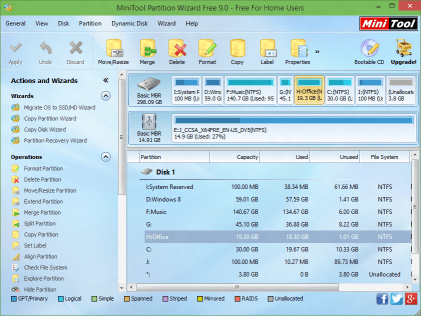


- #Serial para minitool partition wizard 9 serial
- #Serial para minitool partition wizard 9 driver
- #Serial para minitool partition wizard 9 tv
The original USB 3.0 speed reaches 5.0Gbps (640MB/s), and its maximum output current is 5V/900mA. Therefore, you can distinguish between USB 2.0 and USB 3.0 through the pins (USB 2.0 only has 4 pins).

It adopted a design of 9 pins-among them, the first row of 4 pins is the same as USB 2.0, and the second row of 5 pins is specially prepared for USB 3.0. The USB 3.0, also named USB 3.1 Gen1/USB 3.2 Gen1, was released in 2008. USB 2.0 speed is 480Mbps (60MB/s) and its maximum output current is 5V/500mA. USB2.0 is still in service since its launch, and it can be said to be the longest-lived USB standard. In 2000, the USB 2.0 (renamed USB 2.0 HiSpeed later) standard officially took the stage and quickly became popular in the following years, and announced the end of many older-generation interface standards. Therefore, their speeds are also USB 2 speeds. Note: USB 1.0 is now renamed USB 2.0 LowSpeed, and USB 1.1 is renamed USB 2.0 FullSpeed. From this version, manufacturers started to try to use the USB standard on their products. In 1998, USB-IF released USB 1.1, which increased transmission rate to 12 Mbit/s (Full Speed) and revised some technical details in USB 1.0. But unfortunately, this USB version was also seldom adopted by manufacturers. The USB 1.0 specified data rates of 1.5 Mbit/s (Low Bandwidth or Low Speed) and maximum output current of 5V/500mA. In 1995, these companies established USB-IF and this organization announced USB 1.0 in the next year. Look at the following chart and you may get a rough concept about USB 1, USB 2, USB 3, and USB4. Then, these companies continued to released USB 0.8, USB 0.9, USB 0.99, and USB 1.0 RC in the following two years.īut these interfaces had little response in the market, and basically no products adopted them. The first USB protocol is USB 0.7, which was jointly proposed by Intel, Compaq, IBM, Microsoft and other companies at the end of 1994.

What Are the Differences Between SD Card VS USB Flash Drive? USB Protocols and Speeds
#Serial para minitool partition wizard 9 driver
Users just need to plug a USB device into a port on a running computer, and then the USB driver will be installed and configured automatically to access the USB device. Small devices can be powered directly from the USB interface, eliminating the need for additional power supply cables.It supports hot-swap, allowing devices to be exchanged without rebooting the host computer.USB interface has the following advantages:
#Serial para minitool partition wizard 9 tv
Currently, the USB interface is widely used in information, communication, and photography products like PCs, mobile devices digital TV (set-top boxes), game consoles, etc. However, nowadays, these interfaces have been substituted by USB interface.
#Serial para minitool partition wizard 9 serial
Universal Serial Bus (USB) is an interface standard that specifies how two devices (usually a computer/phone and the other USB device) connect, communicate and exchange power.


 0 kommentar(er)
0 kommentar(er)
